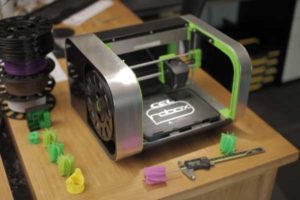Exploring curiosity through 3D printing has serious potential for faculty and students in the classroom

The rise in popularity for 3D printing in recent years could easily be considered the next Industrial Revolution.
In fact, the theme of the Inside 3D Printing Conference this year was “The Third Industrial Revolution,” which speaks to how 3D printing opens up the door to more product manufacturing at home.
We’ve already begun to see how 3D printing has made significant changes to how we live today – from small business to medical advancements – so it comes as no surprise that 3D printing and education have been gaining mainstream attention. Here’s why:
The educational benefits offered with 3D printers are abundant
There is an enormous trend in the “maker movement” for students and, thus, 3D printing and education seem to have a promising future together. The shift towards “making” in the classroom means students and teachers learn together through direct experience – teaching students the basics of design and engineering through a more fun, demonstrative experience than any textbook lesson.
(Next page: Watch how it works)
Students can now build tangible models of their ideas and creations instead of just imagining them. Further educational benefits of 3D printers include encouraging team activity and collaboration – offering opportunities across all subject matters, from science to history. Incorporating 3D printing in education adds value in teaching a broad range of skills and the opportunities are truly endless.
3D printing fuels creativity among students
As 3D printing continues to go mainstream, printers will become commonplace in schools as they encourage hands-on learning. Students can use the prototyping capabilities of 3D printers to bring their creative ideas and designs to life, inspiring individuals’ innovations and inventions.
From rockets to iPad stands, every student can be an inventor with access to a 3D printer – students interested in design, architecture and engineering can make prototypes of their ideas and creations, allowing them to design something unique and hold the model of the design in their hand, instantly being able to assess how to improve on their own ideas. Through trial and error, creativity is reinforced as new ideas are inspired.
[field name=iframe2]
3D printing is the next wave of classroom technology
Just as the iPad made its way into classrooms nationwide, future generations will grow up with 3D printing technology around them. What does this mean exactly? While it may not seem obvious, people of all ages can (and will) use 3D printers, students especially.
Looking forward, parents and faculty alike are encouraged to not only explore their own curiosity in 3D printing, but encourage their students to do the same.
Chris Elsworthy is CEO of Robox.

